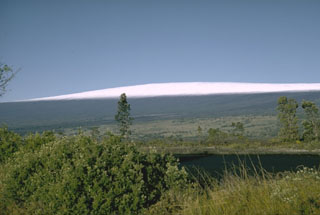Report on Mauna Loa (United States) — November 1976
Natural Science Event Bulletin, vol. 1, no. 14 (November 1976)
Managing Editor: David Squires.
Mauna Loa (United States) Increased seismicity during 20-24 November
Please cite this report as:
Global Volcanism Program, 1976. Report on Mauna Loa (United States) (Squires, D., ed.). Natural Science Event Bulletin, 1:14. Smithsonian Institution. https://doi.org/10.5479/si.GVP.NSEB197611-332020
Mauna Loa
United States
19.475°N, 155.608°W; summit elev. 4170 m
All times are local (unless otherwise noted)
A substantial increase in the number of earthquakes beneath Mauna Loa was recorded 20-24 November (table 1). On the morning of 25 November, only one earthquake was recorded (beneath the NE rift). The USGS predicts a major eruption of Mauna Loa within the next 18 months.
Table 1. Earthquakes recorded at Mauna Loa during 20-24 November 1976.
| Date | Event Totals |
| 20 Nov 1976 | 350 |
| 21 Nov 1976 | 200-300 |
| 22 Nov 1976 | 200-300 |
| 23 Nov 1976 | more than 300 |
| 24 Nov 1976 | less than 100 |
Geological Summary. Massive Mauna Loa is a basaltic shield volcano that rises almost 9 km from the ocean floor to form the world's largest Holocene volcano. Flank eruptions typically occur from the lengthy NE and SW rift zones, and from the Moku'aweoweo summit is caldera, which is within an older and larger 6 x 8 km caldera. Two of the youngest large debris avalanches documented in Hawaii traveled nearly 100 km from Mauna Loa; the second of the Alika avalanches was emplaced about 105,000 years ago (Moore et al., 1989). Almost 90% of the surface of the volcano is covered by lavas less than 4,000 years old (Lockwood and Lipman, 1987). Beginning about 1,500 years ago, a series of voluminous overflows from a summit lava lake covered about 25% of the volcano's surface. Over the last 750 years, from shortly after the formation of Moku'aweoweo caldera until the present, an additional 25% of the volcano has been covered with lava flows, mainly from summit and NW rift zone vents.
Information Contacts: UPI

